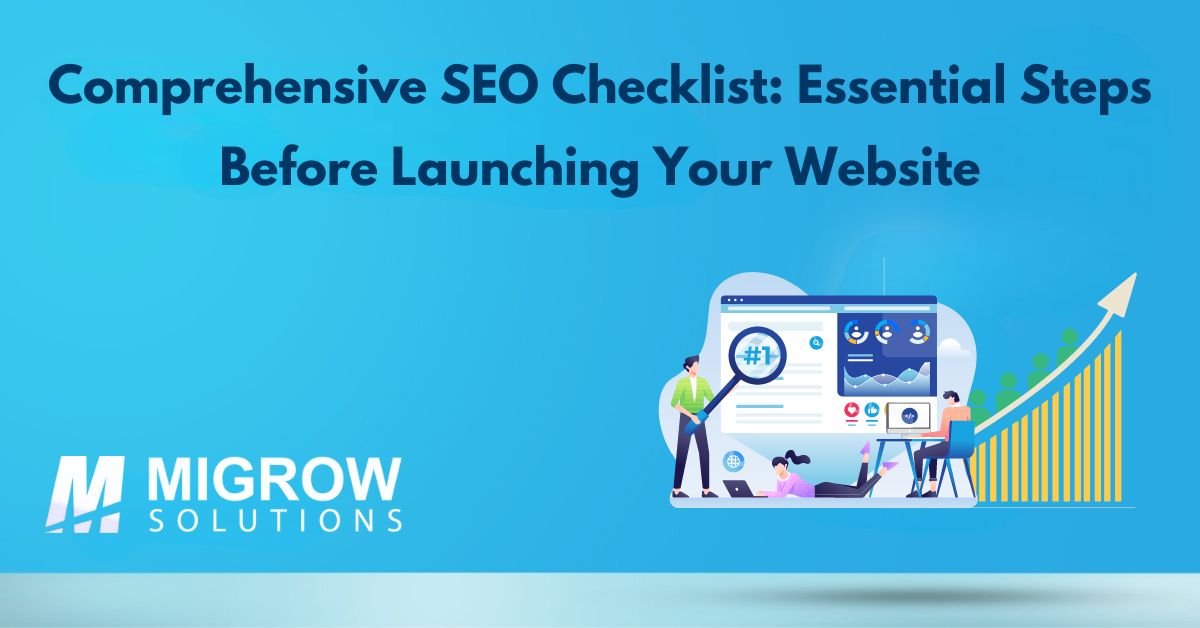
Comprehensive SEO Checklist: Essential Steps Before Launching Your Website
Launching Your Website?
Here's Your Essential Pre-Launch SEO Checklist
Launching a new website is an exciting milestone for any business. However, before you go live, ensuring your website is fully optimized for search engines is crucial. A solid SEO strategy is key to achieving high visibility, better rankings, and overall success online. Below is a comprehensive pre-launch SEO checklist to guide you through the process.
1. Crawl and Indexing
Before making your website live, ensure that it’s easily crawlable and indexable by search engines:
Crawlability: Confirm that all pages are crawlable and not mistakenly tagged with "no-index."
XML Sitemap: Submit your XML sitemap to Google Search Console and Bing Webmaster Tools.
Robots.txt: Double-check that your robots.txt file isn't blocking important pages from being crawled.
2. Technical SEO
Technical SEO forms the backbone of a well-optimized website:
Site Speed: Page load times are critical. Use tools like Google PageSpeed Insights to test your speed. Optimize images and minimize CSS/JavaScript.
Mobile-Friendliness: With mobile dominating search traffic, ensure your site is responsive and works on all devices. Test using Google’s Mobile-Friendly Test.
HTTPS Security: Secure your site with an SSL certificate, and ensure all pages redirect from HTTP to HTTPS.
Canonical Tags: Use canonical tags to avoid duplicate content issues.
404 Errors and Broken Links: Fix broken links and ensure 404 pages guide users to relevant content.
Structured Data Markup: Implement schema markup for rich snippets and validate it using Google’s Structured Data Testing Tool.
AMP (Accelerated Mobile Pages): If applicable, implement AMP for faster mobile loading.
3. On-Page SEO
On-page SEO focuses on optimizing individual pages to rank higher in search results:
Meta Titles and Descriptions: Ensure each page has a unique, keyword-optimized meta title and description.
Header Tags (H1, H2, H3): Use header tags to structure content and improve readability.
Content Optimization: Optimize content with relevant keywords and ensure it’s engaging for users.
Image Alt Text: Add descriptive alt text to all images.
URL Structure: Use clean, SEO-friendly URLs that include target keywords.
Internal Linking: Implement a logical internal linking structure that aids navigation and passes link equity.
4. Off-Page SEO
Off-page SEO is essential for building your website’s authority:
Backlinks: Analyze your backlink profile using tools like Ahrefs or Moz to ensure quality links are pointing to your site.
Social Signals: Link your social media profiles to your site and add sharing buttons to boost visibility.
Local SEO: For location-based businesses, optimize your Google My Business profile and ensure consistent NAP information across the web.
5. Analytics and Tracking
Proper tracking helps you monitor your site’s performance:
Google Analytics: Set up Google Analytics to track site performance and configure goals.
Google Search Console: Verify your site ownership and configure settings.
Conversion Tracking: Track key conversion points such as form submissions and e-commerce transactions.
Heatmaps and A/B Testing: Use tools like Hotjar to analyze user behavior and run A/B tests.
6. Content Review
High-quality content is vital for success:
Duplicate Content Check: Use tools like Copyscape to ensure your content is unique.
Blog Optimization: Optimize blog posts with relevant keywords and meta tags.
Call-to-Actions (CTAs): Review and optimize CTAs to align with user intent.
7. Final Quality Assurance (QA)
Before launching, conduct a final round of QA checks:
Cross-Browser Testing: Ensure your site looks and functions correctly across all browsers and devices.
Site Audit: Run a final audit using tools like SEMrush or Screaming Frog to catch any remaining issues.
8. Pre-Launch Testing
The final step involves testing your site:
Staging to Production: Verify all updates from staging are reflected on the live site.
Check Redirects: Ensure 301 redirects from old URLs to new ones are working.
Load Testing: Test your site’s ability to handle traffic spikes.
Conclusion
By following this pre-launch SEO checklist, you can confidently launch your website, knowing it's optimized for search engines. This preparation will help you rank higher, provide a better user experience, and ultimately drive higher conversions and success.
At Migrow Solution, the leading digital agency in Chennai, we specialize in providing ROI-driven digital marketing services. From technical SEO to performance marketing, we ensure your website is fully optimized for success. Need help with your SEO strategy? Contact us today to get started!


